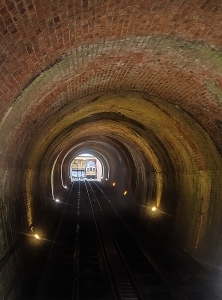Adam Yamey's Blog: YAMEY, page 72
October 28, 2023
A concrete environment: a brave new world
ONE SUNDAY MORNING in October 2023, we arrived in central Milton Keynes (‘MK’). The reason for our visit was to see an exhibition at the MK Gallery. I will describe the exhibition in a future posting. Although it was just after 10 am, there were few people around in the city centre. The little that we saw of central MK reminded me of trips to modern parts of cities in Eastern Europe before the collapse of the so-called ‘Iron Curtain’. However, in comparison with those places, central MK seemed much less lively.
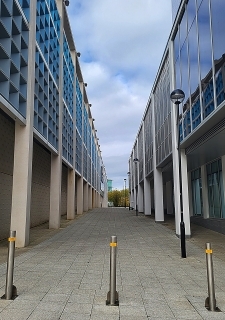
Like New Belgrade and the new parts of Bratislava and Budapest, MK was built after WW2. In the 1960s, the UK government decided that to relieve the housing congestion that had developed in Greater London, new towns should be developed. MK was one of these. It was founded in 1967, and named after one of the villages in the area which the new city covers, rather than, as I had believed, in honour of two economists (John Maynard Keynes & Milton Friedman). Laid out in a grid pattern, it is modernist in conception. Having learned the mistakes made when planning earlier new towns in the UK, MK was designed to have commercial buildings that did not exceed six storeys, and residential that did not exceed three. However, a few taller buildings were added in the 21st century to provide the city with a central landmark. The city was designed by Melvyn Webber (1920-2006), who, according to an article in Wikipedia, believed:
“… telecommunications meant that the old idea of a city as a concentric cluster was out of date and that cities which enabled people to travel around them readily would be the thing of the future, achieving ‘community without propinquity’ for residents.”
Thus, MK has an amazing grid of roads that mostly intersect each other at roundabouts. It also has a high proportion of its area covered with open spaces (greenery and water features). MK was granted formal city status in August 2022. The part of MK we saw – and it was only a small part, but centrally located – has roads separated by wide tree-lined walkways. As already mentioned, the place reminded me of post-war urban developments in the formerly Communist countries of Central and Eastern Europe. I wondered whether the city has been a success. I have read that it makes an important contribution to the economy of the UK, but what I would like to know is how its inhabitants feel about living in what resembles a totalitarian utopia.
October 27, 2023
A steep climb to the memorial to a poet
ALFRED LORD TENNYSON (1809-1892), the famous Victorian poet, had his home, Farringford House, at Freshwater Bay on the Isle of Wight. First, he rented the house in 1853, and then bought it in 1856. Because he was pestered by so many tourists, he moved to Aldworth in West Sussex in 1869. However, he kept Farringford, and spent most winters there. In 1860, his friend, the creative photographer Julia Margaret Cameron (1815-1879), bought a house, Dimbola, which was very close to Farringford.
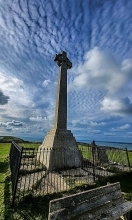
In 1897, a memorial to the poet was erected on Tennyson Down, a clifftop high above Farringford and Dimbola. Designed by JL Pearson, it is a tall stone Celtic cross mounted on a stepped base. A gently sloped footpath leads from Dimbola to the memorial, but we did not use this. Instead, my friend Martin and I laboriously climbed a steeper path closer to it. The cross is impressive and dramatic against the wide-open sky – almost Wagnerian. The views from the clifftop were magnificent on the clear day we visited it.
Our descent from the clifftop was somewhat adventurous. This was not intentional. Because we could not remember the place the path (and staircase), which we ascended, began, we had to create our own route down the steep, almost vertiginous, wooded slopes. We had to be careful not to trip over the numerous tree roots and fallen branches that were hidden under fallen leaves that lay all over the place. I was quite relieved when we reached the car park without having fallen or strained our ankles. Next time I visit the poet’s memorial, I will use the lengthier but safer footpath.
You can read more about Tennyson and Julia Margaret Cameron, “Between Two Islands. Julia Margaret Cameron and her Circle”, available from Amazon sites such as:
October 26, 2023
On planning an itinerary, palindromes, and the Panama Canal
EVERY YEAR EXCEPT for a couple when travel was restricted by regulations connected with the covid19 pandemic, we plan a trip to India. Whilst trying to complete this year’s itinerary, I was reminded of a palindrome, which I first heard from my wife. It goes like this:
“A Man, A Plan, A Canal, Panama!”
This particular palindrome relates to the Panama Canal (constructed between 1904 and 1914), rather than to the Panama hat. The author of this set of words is unknown.
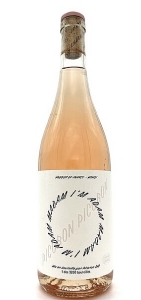
I have long enjoyed palindromes. The one about Panama is one of my favourites. Another, which incorporates my first name, is:
“Madam I’m Adam.”
Again, I do not know who originated it, but I have discovered that there is a Merlot rosè wine from France, which bears that palindrome as its name.
October 25, 2023
A novel about Cornwall by Daphne du Maurier
I HAVE BEEN TO CORNWALL many times, and always enjoy visiting this unique part of the UK. For many years, it was the home of the author Daphne du Maurier (1907-1989). She died in the Cornish town of Fowey, where she had a house, which is still owned by her family. Despite having visited Cornwall so many times, it was only recently (October 2023) that I first read one of her novels. The one I chose is called “The House on the Strand”. It is an exciting book, which is difficult to set aside once you begin reading it.
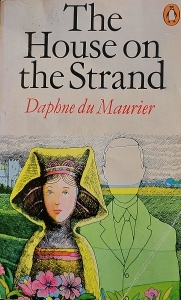
Richard Young is spending a holiday in Cornwall in a house owned by his old friend, a scientist Magnus, who is a professor at the University in London. Magnus has developed a set of related drugs, which he and Richard decide to test on themselves. Both men experience the same effects of these hallucinogenic substances. Within minutes of drinking a dose, they are transported back to 14th century Cornwall and become witnesses to events that they later discover had been recorded in historical records. Both men become witnesses to things that were happening during that far off period in the area where Magnus’s house is located. The desire to know more and more leads both men to keep taking the drug.
Things begin to get complicated when sooner than expected Richard’s wife and his stepchildren join him in Cornwall. The drug has odd side-effects that make Richard’s wife both worried and suspicious. As the days pass, things become more and more complicated, and eventually there is a series of tragic events.
The plot is ingenious and intriguing. By transporting Magnus and Richard back to mediaeval times, the author was able to describe Cornwall today and as it might have been in those days. The novel is also about addiction and how it develops. Further, Du Maurier describes the conflict between truth, half-truth, and deception. Not only is this novel a delightful story about Cornwall but also it is a brilliant depiction of certain types of human behaviour and how it has changed over the centuries.
October 24, 2023
The tunnel of life
October 23, 2023
Creating art with wood and a chainsaw
BORN IN WHAT BECAME EAST GERMANY in the town of Deutschbsaselitz, the artist christened as Hans-Georg Kern (b. 1938), is better known by the name of Georg Baselitz. His first education in art was at Hochschule für Bildende und Angewandte Kunst in East Berlin, commencing in 1955. After two semesters, he was expelled from this academy because of his lack of compliance with the socialist diktats of the German Democratic Republic. By 1957. he was a student at the Hochschule der Künste in West Berlin. In 1961, he changed his name to Georg Baselitz in honour of the town where he was born. In 1979, he began creating sculptural works, some of which are on display at London’s Serpentine South Gallery until the 7th of January 2024.
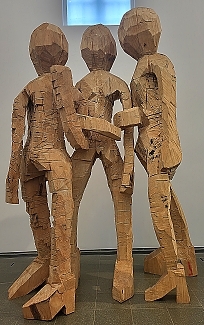
The works being shown at the Serpentine are all made of wood. They were created between 2011 and 2015 as models (maquettes) for finished works, and as such were not originally intended for public display. The wood has a rough finish and is pitted with many saw marks. After making preliminary drawings, some of which are displayed at the exhibition, Baselitz used axes, chisels, and chainsaws to fashion huge bits of timber into intriguing sculptural forms. These works are beautifully displayed in the various spaces of the gallery.
Although Baselitz’s timber sculptures are more figurative and much more complicated than those produced by my mother, seeing them reminded me of her. After leaving the sculpture workshops of St Martins School of Art, my mother hired a garage near Golders Hill Park, and used it as her studio. There, she worked on huge pieces of wood, creating abstract sculptures. Unlike Baselitz, she had no power saws, but only chisels and a power drill. I recall that when she wanted to create a ring-shaped piece of timber, she would first trace circles on the wood and then using a power drill she would drill holes around the circumference until the circle was complete. After that, she had to smooth the edges to produce a perfect circle. It was laborious, and lifting the heavy timber (without lifting gear) damaged her back.
The works on display in the Serpentine (and one outside it) appear to be crudely finished when looked at closely, but as semi-abstract sculptures they seem to mock the grandeur of classical Greek or Roman sculptures. Born a rebel, the artist has produced attractive works that comfortably go against the grain of traditional sculpture.
October 22, 2023
An unusual Victorian funicular still working by the sea
STEEP CLIFFS OVERLOOK Hastings Old Town and the beach immediately east of it. Although there are roads that lead from these parts of Hastings to the rest of the town on top of the cliffs, a more interesting way of travelling between the bottom and the top of the cliffs is by using either the East Hill Lift or the older West Hill Lift. Both are funiculars. We travelled up and down on the West Hill Lift, which travels between the west end of the Old Town and the ruins of Hastings Castle high above on the top of the cliff.
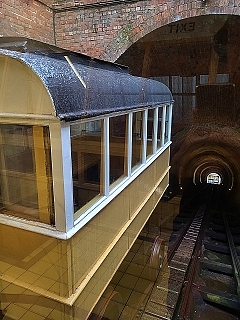
The West Hill Lift (‘WHL’) is 500 feet long and ascends a height of 170 feet, a gradient of 33% (1 in 3). It comprises two tracks, each 6 feet in gauge. It is powered by electricity. The two carriages, which can each hold up to 16 people are raided and lowered along the tracks by steel cables attached to them. They are equipped with a mechanism that automatically applies brakes to the wheels should the cable break. I did not know this when we made a trip up and down the cliff in the creaky old carriages, which are those that were supplied when the system was originally installed.
The construction of the WHL began in 1899 (the year that the Eiffel Tower was built). But it was only completed in 1891, when the cable winders were operated by a gas-powered engine. The funicular system was built by Messrs A H Holme & C W King of Liverpool, who later built the Snowdon Mountain Railway. In 1894, after the Hastings Lift Company went ‘bust’, the WHL was taken over by the Hastings Passenger Lift Company. This company ran it until 1947, when the Lift was bought by Hastings Borough Council. In 1924, the gas engine was replaced by a diesel engine, which was later replaced by an electric motor (in 1971).
Despite having been refurbished in 1991, the WLF still operates with its original 1890s carriages. Admission to these is via an old-fashioned metal turnstile operated by the ticket seller. Apart from looking archaic, a special feature of the WHL is that most of it travels in a brick-lined tunnel burrowed through the cliff. Its neighbour, the East Hill Lift, runs through an uncovered cleft cut in the cliffs. Apparently, few other funiculars in Britain were built, like the WHL, to run through tunnels, and those that were, are no longer in use.
Although Hastings is not nearly as elegant as other British seaside towns such as Eastbourne and Brighton, it is an intriguing place rich in places of historical and visual interest. The existence of the superb Hastings Contemporary art gallery and the two working funiculars adds to the fascination of the place. It is not a place to be ‘sniffed at’.
October 21, 2023
An international annual fair of art in a London park and an artist from Uganda
WE WERE FORTUNATE to have been given a couple of entry tickets to the Frieze art fair held every year in London’s Regents Park. The fair consists of the elaborate stalls (or booths) set up by commercial art galleries and dealers from London and all over the world. It is divided into two sections, each housed in enormous temporary structures. Frieze Masters displays artworks and other artefacts (many of them antiques) created before the year 2000 AD. Although many of the pieces on display are fabulously beautiful and for sale, walking around Frieze Masters is rather like exploring a large museum. The stall by Jonckheere was especially wonderful with its display of paintings by Hieronymus Bosch and others of his era.
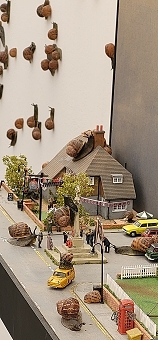
South of the Frieze masters pavilion is the Frieze London pavilion which showcases mainly works created after 2000. I found this to be far more exciting than the Frieze Masters. Many of the exhibitors’ displays had a vibrancy that I found lacking at Frieze Masters. Many of the booths had works by the brilliant, versatile Nigerian British artist Yinka Shonibare, whose works I have seen recently in several other galleries around London. Many other well-known artists such as Grayson Perry had works on display. Three booths, operated by galleries based in India, exhibited works by artists from not only India but also Pakistan and Bangladesh. Amongst the many eye-catching exhibits, there was a collection of works by the artist Patrick Goddard (born 1984). What made this display most interesting was that both the walls of the booth and the artworks were covered by life-like models of snails (see photograph above).
Having seen several exhibitions of contemporary art by African artists during the three days before we visited Frieze, I was attracted to the booth set up by the Stephen Friedman Gallery (London). It contained paintings and sculptures by an artist, Leila Babirye, born in Kampala, Uganda in 1985. She studied art at Makerere University in Kampala, and then participated in the Fire Island Residency (New York State) in 2015. The Residency is a meeting place for visual artists who are (to quote the Residency’s website): “… lesbian, gay, bisexual, transgender, non-binary, intersex and queer …” Ms Babyre is a member of the LGBTQ+ community, which is frowned upon in her native land. Because of this, she received asylum in the USA in 2018, and now both lives and works in Brooklyn, New York City. On display at Frieze, is her collection of colourful portraits, which sre described as “queer identity cards”. A director of the gallery explained that these are a reaction to the formal format of official identity card photographs in which the subject has to remove spectacles, headwear, and tie back their hair. In addition to these, and more interesting visually, there were several sculptures by Ms Babirye. Beautifully crafted, most of them incorporate a variety of different materials – often discarded objects. The point of embellishing her sculptures with what is basically ‘trash’ is to illustrate the word used in the Luganda language to describe homosexuals – ‘ebisiyaga’ meaning ‘sugar cane husk’, in other words ‘it’s rubbish’.
There was plenty more that I found exciting at Frieze London, but the stalls exhibiting artists from the Indian Subcontinent and that showing Leila Babirye wer for me the most interesting. A visit to the Frieze art fair is both exhilarating and exhausting. Luckily, the prices of the artworks were way beyond our budget. Had they not been so costly, I am sure that we would have brought home quite a few of them.
October 20, 2023
There is something fishy about Hastings
THE HASTINGS CONTEMPORARY art gallery is housed in an elegant modern structure. Some of its large windows and the terrace outside its café look out over the fishing vessels moored on the nearby shingle beach. Other windows give the visitor a view of tall wooden sheds covered with overlapping planks of timber painted black. And yet other windows look towards a couple of long-established purveyors of sea food. The timberwork on the outside of the Hastings Contemporary is painted black to match its towering neighbours.
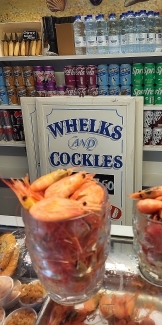
The tall wooden structures are ‘net shop’ sheds used for storing fishing nets and other gear when not in use. They are called ‘shops’ not because they sell something, but because ‘shop’ is an old-fashioned word for ‘workshop’. A newspaper article (www.hastingsindependentpress.co.uk/ar... ) explained further:
“The Hastings net shops are unique: tall, thin wooden sheds, up to three stories high, painted black, standing side-by-side in clear-cut rows on a part of beach near the sea. Sheds of various shapes and sizes have been on this shingle in front of Hastings Old Town for many centuries, but it was a town planning decision in 1835 that created both the remarkable architectural design and the layout that together make this group of buildings unique. The shops are the traditional storage buildings of the Hastings fishing fleet. They were used in the past to stow gear made from natural materials – cotton nets, hemp ropes, canvas sails, etc – which would rot if left in the open, especially when wet. If possible, the items would be dried on the beach first, and then kept dry inside these weather-proof stores. “
The sheds, the fishing vessels, and the fish shops are all spread along Rock-a-Nore Road, which runs between the cliffs and the seashore, which in this part of Hastings is known as ‘The Stade’. The word ‘stade’ is derived from a Saxon word meaning ‘landing place’.
The two fish shops caught my attention. One of them is called The Net Shop – a jellied eel bar. It is appropriately named because it is right next to a net shop. Established in 1943, this place sells a variety of traditional English seaside seafood delicacies such as: jellied eels, cockles, mussels, oysters, whelks, winkles, dressed crab, prawns, baby octopus, shrimps, crayfish tails, lobster, ocean sticks, and so on. With the exception of the jellied eels, all of the seafood on display looked delicious to me.
The Net Shop jellied eel bar is separated from the Rock-a-Nore Fisheries by the already mentioned timber net shop. The Fisheries shop was started by a member of a family, who had been fishermen since the 19th century. Albert and Lilly set up the shop over 30 years ago. Today, the shop is run by their son Sonny and other members of his family. Sonny’s grandmother:
“… Polly Gannon, used to push a fish cart seven miles from Hastings to Bexhill and back again every day before his parents Albert & Lilly set up Rock-a-Nore Fisheries some 30 years ago.” (https://hastingsflyer.com/hastings-old-town-businesses/).
Sonny’s shop sells wide variety of fish and other seafood. In part of the shop there is an oak-chip fired smokery for smoking seafood. One of their products is smoked salmon. Albert, who worked as a chef in the renowned Brown’s Hotel in Mayfair, enjoyed experimenting with food. He invented a smoked salmon cure, which has been used in the shop for many years – its recipe is a well-guarded secret. Smoked sea salt is also on sale.
Had we been staying for a few days in Hastings in accommodation with cooking facilities, I am certain that we would have been regular customers at both the Net Shop and its near neighbour, Rock-a-Nore Fisheries. However, on our most recent visit, we were only in this charming fishing town for a few hours.
October 19, 2023
A working men’s club with an unusual name
HASTINGS IN EAST SUSSEX has long had a thriving fishing fleet. It is the largest beach-launched fleet in Europe. Unlike many other fishing ports where the boats are moored in harbours, those at Hastings are moored along the town’s shingle beach when they are at rest. This is part of the beach where in 1066, William the Conqueror famously set foot on English soil.
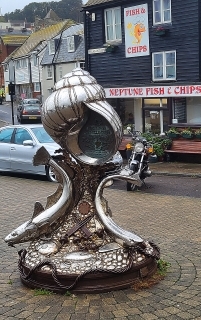
In 1900, a group of Hastings fishermen met in the (now non-existent) Prince Albert pub – a popular meeting place for these men. The members of the group discussed the idea of raising money to give the poor children of the borough a happy time at Christmas. At that time, regulars of another Hastings pub, the Royal Oak, formed a charitable organisation called the Acorn Club. A website (https://winkleclub.org/early-times/) revealed:
“Apparently at that time in another Hastings pub, the Royal Oak, an Acorn Club had been formed. All members had always to carry acorns, failure to do so involving a fine, all such money being devoted to charity. The fishermen decided to organise an effort on the same lines but one of them … said: `Why an acorn? This is the Old Town; can’t we have something to do with fishing?’ Just then, so the story goes, Providence took a hand. Somebody appeared with a pail of winkles collected from the rocks. Inspiration! Let’s make it the Hastings Winkle Club.”
Thus, the Winkle Club of Hastings was ‘born’.
Members of the Winkle Club must carry a winkle shell at all times. When challenged by a member with the words “Winkle up”, the challenged member must produce his winkle shell and show it to the challenger. For, if they are discovered without their winkle, they are fined. Originally, the fine was one (old) penny, now it is £1. If the person who discovered a member without a winkle did not report him, he would also be fined. All the fines are donated to raise money to achieve the club’s objectives.
In the past, the Winkle Club raised money for poor children as already mentioned. Now, the club raises money for local good causes. Over the years, the Club has included some famous members, who were not fishermen. These include Winston Churchill, the Duke of Windsor, and Lord Montgomery of Alamein.
Close to The Stade, the part of Hastings where the fishing boats are moored, there is a traffic island known as Winkle Island. It is used for various local festivals and is the symbolic meeting place for members of the Winkle Club. A huge sculpture of a winkle shell (see photograph above) stands on Winkle Island. It serves as a public collecting box for the charity. Seeing this marine sculpture is what aroused my interest in this thoroughly worthy charitable organisation.

